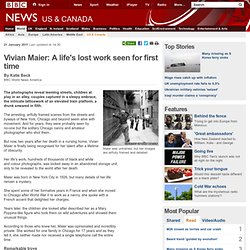

“Inventing Vivian Maier” by Abigail Solomon-Godeau [EN] Version française First she was found, as announced in the title of one of the two documentary films about her (Finding Vivian Maier), but now it can be justly said her life now requires posthumous invention.
![“Inventing Vivian Maier” by Abigail Solomon-Godeau [EN]](http://cdn.pearltrees.com/s/pic/th/inventing-magazinejeu-magazine-66181562)
And, for the most part, this invention is necessitated by Maier’s voluminous production and its entrance into the photographic marketplace. This, however, is only one of a number of issues raised by both her life and work. As it happens, her job as a nanny – an explicitly gendered profession – was itself an occasion for much of her photography. It also risks becoming a branding moniker: Who Took Nanny’s Pictures? Vivian Maier, Self-portrait, undated© Vivian Maier / Maloof Collection. In her provocative essay of 1984, “Landscape/View: Photography’s Discursive Spaces,” Rosalind Krauss addressed the complexities (and contradictions) of the art historical notion of “oeuvre” when applied to photographic production. Vivian Maier, St. Abigail Solomon-Godeau, 2013. To Deepen the Mystery: The Self-Portaits of Vivian Maier. Pinterest. The 8mm Films of Vivian Maier. Vivian Maier Photography. Vivian Maier: A life's lost work seen for first time. 21 January 2011Last updated at 14:30 By Katie Beck BBC World News America Maier was untrained, but her images are artfully framed and detailed The photographs reveal teeming streets, children at play in an alley, couples captured in a sleepy embrace, the intricate latticework of an elevated train platform, a drunk smeared in filth.

The arresting, artfully framed scenes from the streets and byways of New York, Chicago and beyond seem alive with movement. And for years, they were probably seen by no-one but the solitary Chicago nanny and amateur photographer who shot them. But now, two years after her death in a nursing home, Vivian Maier is finally being recognised for her talent after a lifetime of obscurity. Her life's work, hundreds of thousands of black and white and colour photographs, was locked away in an abandoned storage unit, only to be revealed to the world after her death. Maier was born in New York City in 1926, but many details of her life remain a mystery.
Remarkable trove. Vivian Maier - Her Discovered Work. Vivian Maier. Personal life[edit] Many details of Maier's life remain unknown.

She was born in New York City, the daughter of a French mother, Maria Jaussaud Justin, and an Austrian father, Charles Maier (also known as Wilhelm). Several times during her childhood she moved between the U.S. and France, living with her mother in the Alpine village of Saint-Bonnet-en-Champsaur near her mother's relations. Her father seems to have left the family temporarily for unknown reasons by 1930. In the 1930 census, the head of the household was listed as Jeanne Bertrand, a successful photographer who knew Gertrude Vanderbilt Whitney, founder of the Whitney Museum of American Art.[7][8] In 1935, Vivian and her mother were living in Saint-Julien-en-Champsaur and before 1940 returned to New York.
John Maloof, curator of some of Maier's photographs, summarized the way the children she nannied would later describe her: "She was a Socialist, a Feminist, a movie critic, and a tell-it-like-it-is type of person.